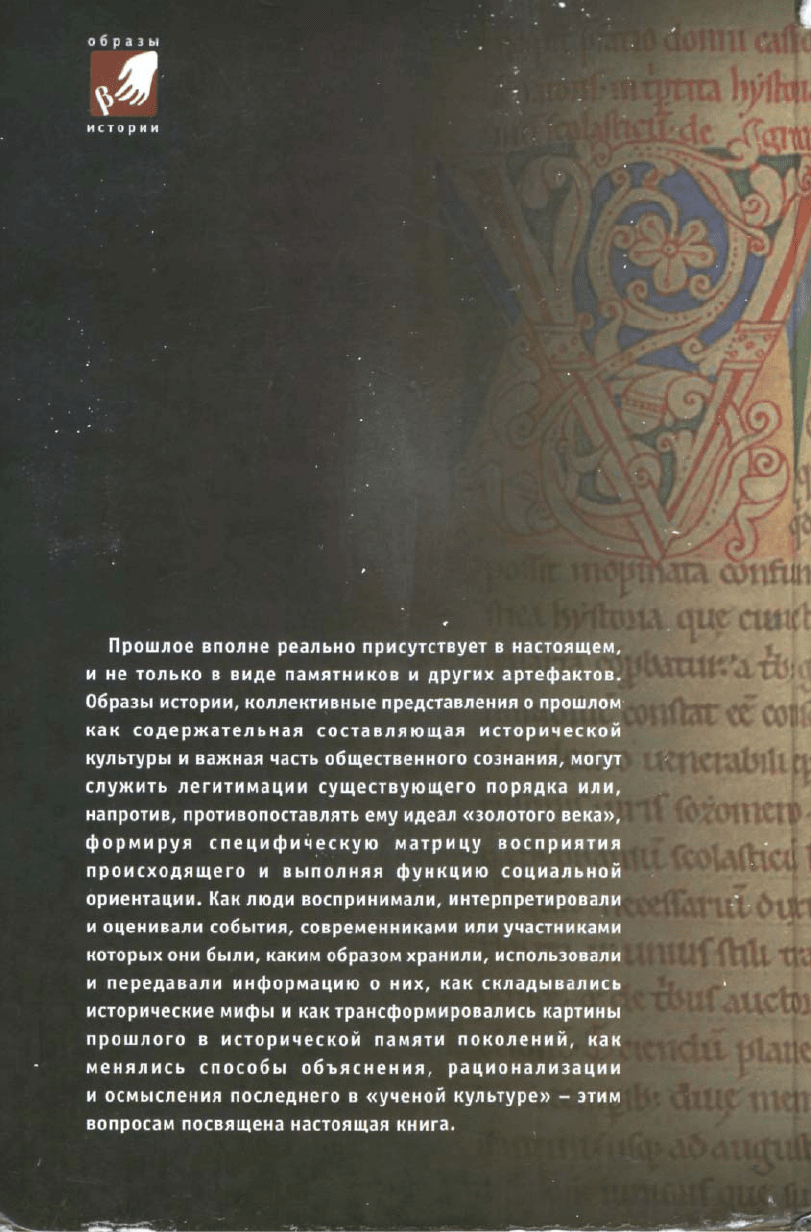Репина Л.П. (ред.) История и память: историческая культура Европы до начала нового времени
Подождите немного. Документ загружается.


kingdom faithful to Orthodoxy had begun in times immemorial, that its first Christian ruler Vladimir was a model of
monarch, and Russia was led by God through actions of pious princes of the dynasty of Vladimir.
Other topic important for Moscow ideology of the XVI
th
c. was the theme of Kiev heritage. It was first dealt with in
the will of Dmitrij Don-skoj. Later texts written after Moscow had got its sovereignty, and after the coronation of
Ivan IV, developed the idea that Russia had been baptized by the Apostle Andrew. It was claimed that Moscow and
Roman traditions were of same value. In the XVI
th
c. Russia accepted the saint patron of Byzantium — St Andrew.
Moscow was viewed as the second Constantinople, and at the same time — as the second Kiev. As for Prince
Vladimir, in the XIV
th
c. he was called 'saint' and 'Baptist'; in the early XV
1
c. — 'equal to Apostles'. In the mid-
XVI
1
'
1
c. Muscovite scholars claimed that rights of St Vladimir were inherited — through dynastic succession — by
the tsar Ivan IV.
Political preeminence of Russia was based on sovereignty (Moscow had it unlike Kiev). St Vladimir was thought of
as the ancestor of the princes of Moscow. Political power of Moscow was explained by its piety, and the Church of
Kiev was presented as loosing its sanctity, which it had gotten at the times of the baptism. Some developed concepts
of translation of grace from Kiev to Moscow (a variant oflranslatio Imperil).
In the mid-XVl"
1
c. the theme of Kiev heritage was closely connected with Russian foreign policy. The task of
liberating all territories of former Kiev Rus' served as ideological justification for the Livonian war.
One could see how the conversion theme was developed through the use of a Ukrainian text of the XVII
th
c.
('Palinodia' by Zacharia Kopys-tensij, 1617-1624). Zacharia's story of conversion is based on the Primary Chronicle
as well as on Greek, Latin and Polish historical writings. The author used the baptism of Russia by St Vladimir to
show the importance of the Russian Church in universal Christendom. Zacharia treated the schism as the apostasy of
the Catholic Church from the true faith. But at the same time when Christendom lost Rome it got newly converted
Russia. Thus through baptism Russia got not only the Christian faith but also the sanctity of the Roman see.
However Kopystenskij did not speak
Memory, Images of the Past...
763
of the translation of grace from Kiev to Moscow. His ideas presented canonic arguments for creation of the new
Patriarchate in Kiev.
In 1632-1643 an anonymous Ukrainian author made a pro-Moscow adaptation of 'Palinodia' — 'The Book of faith'.
In this version the legend on St Andrew's coming into Russia proved that Moscow could be called the apostolic see
(as Constantinople). In the late XVI
th
c. the weightiest argument for creating a new Patriarchal see in Moscow was
the purity of its faith. Texts intended for Russians operated by the complex of ideas known as 'Moscow is the third
Rome'. Apart from concepts of dynastic succession and of the translation of grace new arguments were used:
Moscow had Holy relics of St. Andrew and St. Vladimir. Moscow was seen as new Kiev and Kiev should be
subjected to the see of Moscow.
'The Book of Faith' (the adaptation of 'Palinodia') was used as a source for the introductory part of 'Kormchaya' by
the Patriarch Nikon (1650-1653). As in the source the beginning of Russian Christian history was connected with
the apostasy of Rome. But in this text the general history of Christendom and the Roman apostasy was viewed as
prelude for the history of the Church of Moscow, and Kiev period was included into the latter part. Thus in the
initial Ukrainian version Kiev was the focus of attention while in Moscow versions Kiev period ended with St
Vladimir. All the rest was the history of Moscow.
Both Ukrainian and Moscow Churches turned to the images of St Andrew and St. Vladimir at the periods of
changes: in Russia it was the establishing of sovereign state, autocephalia, the coronation of Ivan IV, the
Patriarchate, the Church reform of the XVIl
(h
c., the war for Ukraine; for Ukraine it was the Union.
Historical legends of Russian diplomacy (Posol'skij Prikaz) also shaped Russian identity and at the same time
expressed it. They consolidated an 'imaginary community' by the stories of God's grace shown to Russian Princes,
Orthodox virtues, glorious victories etc. In diplomatic registers one could find historical justifications of accepting
the title of tsar, genealogical legends, claims to power over 'all Russia'. Russian imperial schemes often came into
conflict with analogous cultural constricts of other countries.
Russian diplomacy adopted the tradition of Byzantine chronographs. Particular legends were put into groups
according to certain rules. Such example as a narrative structure was extremely short and simplified so it presented
minimum of details together with formula. Forms had being changed according to the needs of time but they also
could be viewed as logical stages in development of imperial myth making. Imperial symbols and rhetoric
dominated the text but particular historical details were under constant revision, and it influenced the Russian
historiography.
CONTENTS
INTRODUCTION The Culture of History as a Subject of Research (L, P. Repina).......... 5
I. Memory and the Writing of History (i. P. Repina)...,.................... 19
II. The Culture of Remembrance and the History of Memory
(Yu. A. Arnautova)........................................................ 47
ANTJQUITY
CHAPTER 1
Paradoxes of Historical Memory in Ancient Greece

(/. E. Surikov)................................................................... 56
CHAPTER 2
Roman Annals; Making of a Genre (O. V. Sidorovich)................... 87
CHAPTER 3
Mythology of Historical Memory in Late Antiquity and Early
Middle Ages (P. P. Shkarenkov)............................................. 138
WESTERN EUROPE MIDDLE AGES AND EARLY MODERN PERIOD
CHAPTER 4
Historical Memory in German Oral Tradition
(E. A. Mel'nikova)............................................................. 180
CHAPTER 5
images of the Past in the Writings by Christian Historians
of the Early Middle Ages (V. V. Zvereva)................................... 223
CHAPTER 6
Representation of the Past by a Medieval Historian:
Einhard and his Writings (M S. Petroff).................................... 242
CHAPTER 7
The Image of History and Historical Conscience in Latin
Historiography of the X-XIIl"
1
ее. (Ум. A. Arnautova)................... 277
CHAPTER 8
Memnria of the House of Welf: a Tradition of an Aristocratic Family
(O. G.Oexle).................................................................. 308
CHAPTER 9
An Idea of Authenticity in Medieval Historical Tradition
(E. V. Kalmykova)............................................................. 339
CHAPTER 10
The Norman Conquest in the English Historiography oftheXIII-XlV'cc. (M. M. Gorelov)..................................... 369
CHAPTER 11
"Historical" Memory in the Writings by Female Visioners
of the Late Middle Ages (A. G. Soupriyanovich)......................... 388
CHAPTER 12
The Culture of History in Quattrocento
(Yu. V.Ivanova,P. V. LeSshenko)........................................... 410
CHAPTER 13
Continuity and Innovation in the Culture of History of the Late
Middle Ages and the Early Modern Period (M S. Bobkova)............ 455
CHAPTER 14
History and the English Religious Controversies in the XVI'
and the Early XVir cc. (A. Yu. Seregina)................................. 506
RUS' — RUSSIA IN THE XVII
TH
CENTURY
CHAPTER 15
Religious Aspects of Historical Memory in Rus' before Mongols
(/. V. Vedyushkina)............................................................ 554
CHAPTER 16
The Earliest Period of Russian History in Historical Memory of
Moscow Kingdom (A. S. Usachev).......................................... 609
CHAPTER 17
Moscow as New Kiev, or Where did the Baptism of Rus' Take Place? A View of the Early XVII
Ih
Century. (T. A.
Oparina)........... 635
CHAPTER 18
History Serving Diplomacy: Memory and Diplomacy
in the XVI
th
Century Russia (K. Yu. Erusalimskij)........................ 664
CONCLUSION
Historical Culture in Pre-Modem Europe (L. P. Repina).................... 732
Memory, Images of the Past and Historical Culture
in pre-Modern Europe (L. P. Repina)................................................. 740
CONTENTS............................................................................ 764
СОДЕРЖАНИЕ
ВВЕДЕНИЕ
Историческая культура как предмет исследования (Л. П. Репина).. 5
I. Память и историописание (Л. П. Репина).................................. 19
П. Культура воспоминания и история памяти (Ю. А. Арнаутова). 47
АНТИЧНОСТЬ
ГЛАВА 1
Парадоксы исторической памяти в античной Греции
(И. Е. Суриков)................................................................ 56

ГЛАВА 2
Римская анналистика: становление жанра (О. В. Сидорович)...... gy
ГЛАВА 3
Мифология исторической памяти на рубеже Античности и
Средневековья (П. П. Шкаренков)....................................... 138
ЗАПАДНАЯ ЕВРОПА СРЕДНИЕ ВЕКА И РАННЕЕ НОВОЕ ВРЕМЯ
ГЛАВА 4
Историческая память в германской устной традиции
(Е. А. Мельникова}........................................................... 180
ГЛАВА 5
Образы прошлого у раннесредневековых христианских
историков (В. В. Зверева)................................................... 223
ГЛАВА 6
Репрезентация прошлого средневековым историком:
Эйнхард и его сочинения (М. С. Петрова).............................. 242
ГЛАВА 7
Образ истории и историческое сознание в латинской
историографии X-XIII веков (Ю. А. Арнаутова)...................... 277
ГЛАВА 8
Memoria Вельфов:
домовая традиция аристократических родов (О. Г. Эксле)......... 308
ГЛАВА 9
Представление о достоверном в Средневековой исторической традиции (Е. В. Калмыкова)...............................................
339
ГЛАВА 10
Нормандское завоевание в английском историописании
XIII-XIV веков (М М. Горелов)........................................... 369
ГЛАВА 11
«Историческая» память в женской визионерской литературе позднего Средневековья (А. Г. Суприянович)..........................
388
ГЛАВА 12
Историческая культура Кватроченто
(Ю. В. Иванова, П.В.Лещенко).......................................... 410
ГЛАВА 13
Преемственность и новации в исторической культуре позднего Средневековья и начала Нового времени (М. С.
Бобкова).......... 455
ГЛАВА 14
История и английская религиозная полемика
XVI -начала XVII веков (А. Ю. Серегина)............................. 506
ДРЕВНЯЯ РУСЬ — РОССИЯ XVII ВЕКА
ГЛАВА 15
Историческая память домонгольской Руси:
религиозные аспекты (И. В. Ведюшкина)............................... 554
ГЛАВА 16
Древнейший период русской истории в исторической памяти Московского царства (А. С. Усачев).....................................
609
ГЛАВА 17
Москва как новый Киев, или Где же произошло Крещение Руси: взгляд из первой половины XVII века (Т. А.
Опарина).............. 635
ГЛАВА 18
История на посольской службе: дипломатия и память
в России XVI века (К: Ю, Ерусаяимский).............................. 664
ЗАКЛЮЧЕНИЕ
Историческая культура Европы до начала Нового времени
(Л. П. Репина)................................................................... 732
Memory, Images of the Past and Historical Culture
in pre-Modern Europe (L. P. Repina)................................................. 740
CONTENTS............................................................................ 764
СОДЕРЖАНИЕ....................................................................... 766

